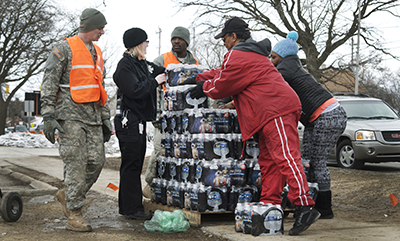‘Preventing the Next Flint’.

Tap water with lead levels a thousand times the legal limit. A possible outbreak of Legionnaires’ disease. Thousands of people relying on donated bottled water.
“People just refer to this as ‘Flint’ now,” Wendy Heiger-Bernays said, summing up the water crisis in the now-infamous Michigan city.
At the February 12 mini-symposium “Preventing the Next Flint,” researchers, an activist, and a member of the Massachusetts Water Resources Authority reflected on how water safety can go wrong scientifically, politically, and socially. As the event began, Heiger-Bernays, associate professor of environmental health, reminded the audience “Flint” is not the name of a crisis, but of a population of people in crisis.
The effects of that crisis will remain long after the water delivery system of Flint is fixed, explained Jonathan Levy, professor of environmental health. For the children of that community, the damage has already been done.
Epidemiological evidence shows more lead exposure in kids correlates to lower IQ and lower reading ability. That isn’t just the case for high levels of exposure, Levy noted, pointing out how the graph of exposure-related effects shows a straight, diagonal line. “There are still effects in people who are being exposed to lower levels” of lead, Levy said. The whole population, he explained, is being pushed toward the lower-performing end.
The damage can be mitigated, Levy added, with enriched learning environments and other educational steps to help get kids up to speed—but where neglected infrastructure causes lead exposure in the first place, “having funds to do that can be difficult.”
The crisis in Flint is a step back in nationwide reduction of lead exposure, said Stephen Estes-Smargiassi, director of planning and sustainability at Massachusetts Water Resources Authority (MWRA). The decrease in exposure since the 1970s “is one of the best curves we’ve ever seen,” he pointed out, explaining the drop is due to a range of steps including removing lead from gasoline and significantly reducing the number of lead service lines in water supply systems.
The Boston area, Estes-Smargiassi added, is down to 5 percent lead service lines. Those lines are taken care of to avoid corrosion leading to exposure, and Boston residents can even see where lead pipes are with an interactive online map.
The care and transparency Estes-Smargiassi described is far from universal, said Lindsey Butler. A trainee at the Boston University Superfund Research Program, Butler is working on a study of prenatal exposure to tetrachloroethylene (PCE)-contaminated drinking water in Massachusetts and Rhode Island.
The study requires basic information about water systems, but Butler said water supply records are woefully spotty: “I’ve actually been offered a shovel on more than one occasion.” She described the hand-cranked microfilm reader used for most Massachusetts drinking water records, and even asking for old framed maps off of municipal office walls.
When it comes to Flint’s lead pipes, the situation is even worse: “Flint’s water records are on 45,000 hand-written index cards,” she said.
“What if Flint is the tip of the iceberg?” Butler asked. “We’re facing an infrastructure crisis, and we’re not going to know where to begin.”
Flint certainly represents a larger problem of neglected communities, said Kalila Barnett, executive director of Alternatives for Community and Environment (ACE), based in Boston’s Roxbury neighborhood.
One of the factors that allowed the Flint water crisis to occur, she said, was “straight-up environmental racism.” The demographics of a community, Barnett said, are a major factor in where environmentally hazardous activity is placed or allowed to occur—and whose complaints are ignored.
“There’s a particular role that you need to play” as public health researchers and activists, she told the audience: partnerships and relationships with affected communities are vital to working toward environmental health and equality.
Fully understanding what has happened in Flint will take time, the panelists agreed. However, they also hoped responses to the crisis could have wide-reaching positive effects. More attention is being given to water safety across the country, Estes-Smargiassi said.
Apologizing for the expression, he added, “That’s the glass half-full.”
The “Preventing the Next Flint” mini-symposium was sponsored by the Superfund Research Program at Boston University, an interdisciplinary program that conducts and communicates research on the impacts of improperly managed hazardous wastes.